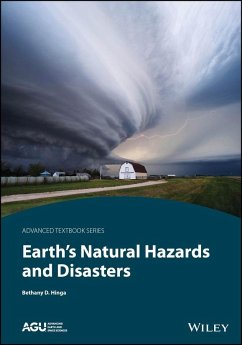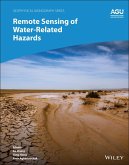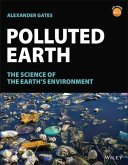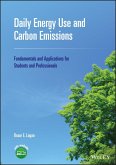Bethany D. Hinga (USA University of Nebraska at Kearney)
Earth's Natural Hazards and Disasters
Schade – dieser Artikel ist leider ausverkauft. Sobald wir wissen, ob und wann der Artikel wieder verfügbar ist, informieren wir Sie an dieser Stelle.
Bethany D. Hinga (USA University of Nebraska at Kearney)
Earth's Natural Hazards and Disasters
- Broschiertes Buch
- Merkliste
- Auf die Merkliste
- Bewerten Bewerten
- Teilen
- Produkt teilen
- Produkterinnerung
- Produkterinnerung
ADVANCED TEXTBOOK SERIES Earth's Natural Hazards and Disasters Natural hazards are present in every part of planet Earth. Sometimes a natural event - such as extreme weather, a volcanic eruption, earthquake or disease outbreak - turns into a disaster for humans, the environment, and the economy. Earth's Natural Hazards and Disasters is a textbook for undergraduates that challenges students to think critically about disasters. It explains the science behind natural events and explores how to understand risk and prepare for disasters. About this volume: * Covers hazards in the geosphere,…mehr
Andere Kunden interessierten sich auch für
![Ecology of Freshwaters - Earth's Bloodstream, Fifth Edition Ecology of Freshwaters - Earth's Bloodstream, Fifth Edition]() Brian R. Moss (University of Liverpool)Ecology of Freshwaters - Earth's Bloodstream, Fifth Edition90,99 €
Brian R. Moss (University of Liverpool)Ecology of Freshwaters - Earth's Bloodstream, Fifth Edition90,99 €![Remote Sensing of Water-Related Hazards Remote Sensing of Water-Related Hazards]() Yang HongRemote Sensing of Water-Related Hazards200,99 €
Yang HongRemote Sensing of Water-Related Hazards200,99 €![History of Climate Change History of Climate Change]() Antonello ProvenzaleHistory of Climate Change32,99 €
Antonello ProvenzaleHistory of Climate Change32,99 €![Polluted Earth Polluted Earth]() Alexander Gates (Rutgers University, NJ, USA)Polluted Earth105,99 €
Alexander Gates (Rutgers University, NJ, USA)Polluted Earth105,99 €![Climate and Society Climate and Society]() Robin Leichenko (State University of New Jersey)Climate and Society77,99 €
Robin Leichenko (State University of New Jersey)Climate and Society77,99 €![Sustainability Sustainability]() Leslie Paul Thiele (University of Florida, Gainesville, FL)Sustainability65,99 €
Leslie Paul Thiele (University of Florida, Gainesville, FL)Sustainability65,99 €![Daily Energy Use and Carbon Emissions Daily Energy Use and Carbon Emissions]() Bruce E. Logan (University Park The Pennsylvania State University)Daily Energy Use and Carbon Emissions87,99 €
Bruce E. Logan (University Park The Pennsylvania State University)Daily Energy Use and Carbon Emissions87,99 €-
-
-
ADVANCED TEXTBOOK SERIES Earth's Natural Hazards and Disasters Natural hazards are present in every part of planet Earth. Sometimes a natural event - such as extreme weather, a volcanic eruption, earthquake or disease outbreak - turns into a disaster for humans, the environment, and the economy. Earth's Natural Hazards and Disasters is a textbook for undergraduates that challenges students to think critically about disasters. It explains the science behind natural events and explores how to understand risk and prepare for disasters. About this volume: * Covers hazards in the geosphere, hydrosphere, atmosphere, and biosphere * Explains the science of hazards in accessible terms * Detailed case studies of specific disasters for each type of natural event * Explores data-based risk mitigation strategies * Discusses the roles of scientists, public officials, and the general public in hazard management The American Geophysical Union promotes discovery in Earth and space science for the benefit of humanity. Its publications disseminate scientific knowledge and provide resources for researchers, students, and professionals.
Produktdetails
- Produktdetails
- AGU Advanced Textbooks
- Verlag: John Wiley & Sons Inc
- Seitenzahl: 544
- Erscheinungstermin: 30. April 2024
- Englisch
- Abmessung: 246mm x 173mm x 25mm
- Gewicht: 1134g
- ISBN-13: 9781119217718
- ISBN-10: 1119217717
- Artikelnr.: 48383183
- Herstellerkennzeichnung
- Libri GmbH
- Europaallee 1
- 36244 Bad Hersfeld
- gpsr@libri.de
- AGU Advanced Textbooks
- Verlag: John Wiley & Sons Inc
- Seitenzahl: 544
- Erscheinungstermin: 30. April 2024
- Englisch
- Abmessung: 246mm x 173mm x 25mm
- Gewicht: 1134g
- ISBN-13: 9781119217718
- ISBN-10: 1119217717
- Artikelnr.: 48383183
- Herstellerkennzeichnung
- Libri GmbH
- Europaallee 1
- 36244 Bad Hersfeld
- gpsr@libri.de
Bethany D. Hinga, University of Nebraska at Kearney, USA.
Contributors xiii
Preface xv
Glossary xvii
Acknowledgments xlv
1 Introduction to Natural Disasters 1
Bethany D. Hinga
1.1 Introduction 1
1.2 The Earth System 4
1.3 Natural Disasters 7
1.3.1 Types of Disasters 7
1.4 Definitions 8
1.5 Disasters Are Predictable 9
1.6 The Human Factor 13
1.7 Increasing Risk 14
1.8 Calculated Risks 16
1.9 The Role of Government in Vulnerability and Preparing for Disasters 18
1.10 Disasters and Social Change 21
1.11 Community Response 21
1.12 Chapter in Review 25
Part I Geologic Events as Hazards
2 Plate Tectonics 31
Bethany D. Hinga
2.1 Introduction 31
2.2 Continental Drift 31
2.3 New Data: Magnetism 35
2.4 Seafloor Spreading 38
2.5 Plate Tectonics 38
2.6 Earth Structure 38
2.7 Plate Boundaries 40
2.8 Subduction Zones 45
2.9 Collision Zones 48
2.10 Transform Boundaries 49
2.11 Hotspots 51
2.12 Conclusion 54
2.13 Chapter in Review 54
3 Volcanoes 57
Bethany D. Hinga
3.1 A Lengthy Eruption With an Unexpected End 57
3.2 Magma Generation 64
3.3 Volcano Behavior 70
3.4 Types of Volcanoes 72
3.5 The Case of Mount St. Helens 83
3.6 Hazards of Composite Volcanoes 90
3.7 Mitigation 96
3.8 Chapter in Review 97
4 Earthquakes 101
Bethany D. Hinga
4.1 Introduction 101
4.2 What Is an Earthquake? 107
4.3 Seismic Waves 111
4.4 How Do Earthquakes Work? 123
4.5 Earthquake Hazards 129
4.6 Prince William Sound Earthquake 138
4.7 Mitigation Strategies 139
4.8 Conclusion 142
4.9 Chapter in Review 142
5 Tsunamis 145
Bethany D. Hinga
5.1 Introduction 145
5.2 Unimak Island Earthquake and Tsunami, 1946 145
5.3 Wave Creation 149
5.4 Wave Characteristics 150
5.5 Wave Parameters 152
5.6 Case Studies 153
5.7 Landslide-Generated Tsunami 161
5.8 Mega-Tsunamis 161
5.9 Volcano-Generated Tsunamis 161
5.10 Mitigation of Tsunami Hazards 164
5.11 Conclusion 166
5.12 Chapter in Review 166
6 Earth Movements 169
Bethany D. Hinga
6.1 The Role of Gravity in Shaping the Earth 169
6.2 Venezuela, 1999 169
6.3 Types of Earth Movements 172
6.4 Mass-Wasting Triggers 188
6.5 Mitigation of Hazards 188
6.6 Conclusion 192
6.7 Chapter in Review 193
Part II Weather and Climate as Hazards
7 Atmosphere and Weather 197
Bethany D. Hinga
7.1 Introduction 197
7.2 The Earth's Atmosphere 197
7.3 Solar Radiation 199
7.4 Weather 202
7.5 Air Masses and Fronts 212
7.6 High and Low Pressure Systems 214
7.7 Conclusion 217
7.8 Chapter in Review 217
8 Severe Weather 221
Bethany D. Hinga
8.1 Blizzard on the Plains 221
8.2 Severe Weather Events 225
8.3 Conclusion 251
8.4 Chapter in Review 252
9 Floods 255
Bethany D. Hinga
9.1 Introduction 255
9.2 Central China Flood 255
9.3 The Nature of Streams 258
9.4 Types of Floods 265
9.5 Flood Mitigation 274
9.6 Chapter in Review 278
10 Hurricanes 281
Bethany D. Hinga
10.1 Introduction 281
10.2 Hurricane Maria, 2017 281
10.3 Tropical Cyclones 287
10.4 Hurricane Hazards 295
10.5 Mitigation 304
10.6 Conclusion 304
10.7 Chapter in Review 305
11 Climate Change 307
Jillian Gregg and John Helms
11.1 Slushballs and Greenhouses: What the Geologic Record Says About
Paleoclimate Compared to the Current Stable Climate That Has Supported
Human Civilization Over the Past 10,000 Years 307
11.2 Climate Change Basics 310
11.3 Natural Hazards Caused Directly and Indirectly by Greenhouse Gas
Emissions and Climate Change 334
11.4 Ocean Impacts 351
11.5 Mitigation of Hazards 356
11.6 Geoengineering 361
11.7 Adaptation 363
11.8 Chapter in Review 365
12 Wildland Fires 369
Bethany D. Hinga
12.1 Introduction 369
12.2 Fire Basics 372
12.3 Fire Behavior 375
12.4 Firefighting in Public Lands 382
12.5 Mitigation of Fire Hazards 386
12.6 Conclusion 387
12.7 Chapter in Review 387
Part III Other Hazards
13 Biological Hazards With COVID-19 Case Study 393
Anni Moore and Austin Nuxoll
13.1 Biological Disasters 393
13.2 Introduction to Microbes 397
13.3 Types of Microbes 398
13.4 Microbes and the Earth System 411
13.5 Factors That Put Populations at Risk 415
13.6 Diseases in the Food Supply 422
13.7 Mitigation of Hazards 423
13.8 Conclusion 428
13.9 Chapter in Review 429
14 Hazards From Space 433
Kelli Wakefield and Joel Berrier
14.1 Space Hazards 433
14.2 Introduction 434
14.3 A History of Catastrophe 434
14.4 Measuring Risk 445
14.5 What Can We Do? 456
14.6 Solar Events 459
14.7 Earth's Future 463
14.8 Chapter in Review 463
Bibliography 467
Index 483
Preface xv
Glossary xvii
Acknowledgments xlv
1 Introduction to Natural Disasters 1
Bethany D. Hinga
1.1 Introduction 1
1.2 The Earth System 4
1.3 Natural Disasters 7
1.3.1 Types of Disasters 7
1.4 Definitions 8
1.5 Disasters Are Predictable 9
1.6 The Human Factor 13
1.7 Increasing Risk 14
1.8 Calculated Risks 16
1.9 The Role of Government in Vulnerability and Preparing for Disasters 18
1.10 Disasters and Social Change 21
1.11 Community Response 21
1.12 Chapter in Review 25
Part I Geologic Events as Hazards
2 Plate Tectonics 31
Bethany D. Hinga
2.1 Introduction 31
2.2 Continental Drift 31
2.3 New Data: Magnetism 35
2.4 Seafloor Spreading 38
2.5 Plate Tectonics 38
2.6 Earth Structure 38
2.7 Plate Boundaries 40
2.8 Subduction Zones 45
2.9 Collision Zones 48
2.10 Transform Boundaries 49
2.11 Hotspots 51
2.12 Conclusion 54
2.13 Chapter in Review 54
3 Volcanoes 57
Bethany D. Hinga
3.1 A Lengthy Eruption With an Unexpected End 57
3.2 Magma Generation 64
3.3 Volcano Behavior 70
3.4 Types of Volcanoes 72
3.5 The Case of Mount St. Helens 83
3.6 Hazards of Composite Volcanoes 90
3.7 Mitigation 96
3.8 Chapter in Review 97
4 Earthquakes 101
Bethany D. Hinga
4.1 Introduction 101
4.2 What Is an Earthquake? 107
4.3 Seismic Waves 111
4.4 How Do Earthquakes Work? 123
4.5 Earthquake Hazards 129
4.6 Prince William Sound Earthquake 138
4.7 Mitigation Strategies 139
4.8 Conclusion 142
4.9 Chapter in Review 142
5 Tsunamis 145
Bethany D. Hinga
5.1 Introduction 145
5.2 Unimak Island Earthquake and Tsunami, 1946 145
5.3 Wave Creation 149
5.4 Wave Characteristics 150
5.5 Wave Parameters 152
5.6 Case Studies 153
5.7 Landslide-Generated Tsunami 161
5.8 Mega-Tsunamis 161
5.9 Volcano-Generated Tsunamis 161
5.10 Mitigation of Tsunami Hazards 164
5.11 Conclusion 166
5.12 Chapter in Review 166
6 Earth Movements 169
Bethany D. Hinga
6.1 The Role of Gravity in Shaping the Earth 169
6.2 Venezuela, 1999 169
6.3 Types of Earth Movements 172
6.4 Mass-Wasting Triggers 188
6.5 Mitigation of Hazards 188
6.6 Conclusion 192
6.7 Chapter in Review 193
Part II Weather and Climate as Hazards
7 Atmosphere and Weather 197
Bethany D. Hinga
7.1 Introduction 197
7.2 The Earth's Atmosphere 197
7.3 Solar Radiation 199
7.4 Weather 202
7.5 Air Masses and Fronts 212
7.6 High and Low Pressure Systems 214
7.7 Conclusion 217
7.8 Chapter in Review 217
8 Severe Weather 221
Bethany D. Hinga
8.1 Blizzard on the Plains 221
8.2 Severe Weather Events 225
8.3 Conclusion 251
8.4 Chapter in Review 252
9 Floods 255
Bethany D. Hinga
9.1 Introduction 255
9.2 Central China Flood 255
9.3 The Nature of Streams 258
9.4 Types of Floods 265
9.5 Flood Mitigation 274
9.6 Chapter in Review 278
10 Hurricanes 281
Bethany D. Hinga
10.1 Introduction 281
10.2 Hurricane Maria, 2017 281
10.3 Tropical Cyclones 287
10.4 Hurricane Hazards 295
10.5 Mitigation 304
10.6 Conclusion 304
10.7 Chapter in Review 305
11 Climate Change 307
Jillian Gregg and John Helms
11.1 Slushballs and Greenhouses: What the Geologic Record Says About
Paleoclimate Compared to the Current Stable Climate That Has Supported
Human Civilization Over the Past 10,000 Years 307
11.2 Climate Change Basics 310
11.3 Natural Hazards Caused Directly and Indirectly by Greenhouse Gas
Emissions and Climate Change 334
11.4 Ocean Impacts 351
11.5 Mitigation of Hazards 356
11.6 Geoengineering 361
11.7 Adaptation 363
11.8 Chapter in Review 365
12 Wildland Fires 369
Bethany D. Hinga
12.1 Introduction 369
12.2 Fire Basics 372
12.3 Fire Behavior 375
12.4 Firefighting in Public Lands 382
12.5 Mitigation of Fire Hazards 386
12.6 Conclusion 387
12.7 Chapter in Review 387
Part III Other Hazards
13 Biological Hazards With COVID-19 Case Study 393
Anni Moore and Austin Nuxoll
13.1 Biological Disasters 393
13.2 Introduction to Microbes 397
13.3 Types of Microbes 398
13.4 Microbes and the Earth System 411
13.5 Factors That Put Populations at Risk 415
13.6 Diseases in the Food Supply 422
13.7 Mitigation of Hazards 423
13.8 Conclusion 428
13.9 Chapter in Review 429
14 Hazards From Space 433
Kelli Wakefield and Joel Berrier
14.1 Space Hazards 433
14.2 Introduction 434
14.3 A History of Catastrophe 434
14.4 Measuring Risk 445
14.5 What Can We Do? 456
14.6 Solar Events 459
14.7 Earth's Future 463
14.8 Chapter in Review 463
Bibliography 467
Index 483
Contributors xiii
Preface xv
Glossary xvii
Acknowledgments xlv
1 Introduction to Natural Disasters 1
Bethany D. Hinga
1.1 Introduction 1
1.2 The Earth System 4
1.3 Natural Disasters 7
1.3.1 Types of Disasters 7
1.4 Definitions 8
1.5 Disasters Are Predictable 9
1.6 The Human Factor 13
1.7 Increasing Risk 14
1.8 Calculated Risks 16
1.9 The Role of Government in Vulnerability and Preparing for Disasters 18
1.10 Disasters and Social Change 21
1.11 Community Response 21
1.12 Chapter in Review 25
Part I Geologic Events as Hazards
2 Plate Tectonics 31
Bethany D. Hinga
2.1 Introduction 31
2.2 Continental Drift 31
2.3 New Data: Magnetism 35
2.4 Seafloor Spreading 38
2.5 Plate Tectonics 38
2.6 Earth Structure 38
2.7 Plate Boundaries 40
2.8 Subduction Zones 45
2.9 Collision Zones 48
2.10 Transform Boundaries 49
2.11 Hotspots 51
2.12 Conclusion 54
2.13 Chapter in Review 54
3 Volcanoes 57
Bethany D. Hinga
3.1 A Lengthy Eruption With an Unexpected End 57
3.2 Magma Generation 64
3.3 Volcano Behavior 70
3.4 Types of Volcanoes 72
3.5 The Case of Mount St. Helens 83
3.6 Hazards of Composite Volcanoes 90
3.7 Mitigation 96
3.8 Chapter in Review 97
4 Earthquakes 101
Bethany D. Hinga
4.1 Introduction 101
4.2 What Is an Earthquake? 107
4.3 Seismic Waves 111
4.4 How Do Earthquakes Work? 123
4.5 Earthquake Hazards 129
4.6 Prince William Sound Earthquake 138
4.7 Mitigation Strategies 139
4.8 Conclusion 142
4.9 Chapter in Review 142
5 Tsunamis 145
Bethany D. Hinga
5.1 Introduction 145
5.2 Unimak Island Earthquake and Tsunami, 1946 145
5.3 Wave Creation 149
5.4 Wave Characteristics 150
5.5 Wave Parameters 152
5.6 Case Studies 153
5.7 Landslide-Generated Tsunami 161
5.8 Mega-Tsunamis 161
5.9 Volcano-Generated Tsunamis 161
5.10 Mitigation of Tsunami Hazards 164
5.11 Conclusion 166
5.12 Chapter in Review 166
6 Earth Movements 169
Bethany D. Hinga
6.1 The Role of Gravity in Shaping the Earth 169
6.2 Venezuela, 1999 169
6.3 Types of Earth Movements 172
6.4 Mass-Wasting Triggers 188
6.5 Mitigation of Hazards 188
6.6 Conclusion 192
6.7 Chapter in Review 193
Part II Weather and Climate as Hazards
7 Atmosphere and Weather 197
Bethany D. Hinga
7.1 Introduction 197
7.2 The Earth's Atmosphere 197
7.3 Solar Radiation 199
7.4 Weather 202
7.5 Air Masses and Fronts 212
7.6 High and Low Pressure Systems 214
7.7 Conclusion 217
7.8 Chapter in Review 217
8 Severe Weather 221
Bethany D. Hinga
8.1 Blizzard on the Plains 221
8.2 Severe Weather Events 225
8.3 Conclusion 251
8.4 Chapter in Review 252
9 Floods 255
Bethany D. Hinga
9.1 Introduction 255
9.2 Central China Flood 255
9.3 The Nature of Streams 258
9.4 Types of Floods 265
9.5 Flood Mitigation 274
9.6 Chapter in Review 278
10 Hurricanes 281
Bethany D. Hinga
10.1 Introduction 281
10.2 Hurricane Maria, 2017 281
10.3 Tropical Cyclones 287
10.4 Hurricane Hazards 295
10.5 Mitigation 304
10.6 Conclusion 304
10.7 Chapter in Review 305
11 Climate Change 307
Jillian Gregg and John Helms
11.1 Slushballs and Greenhouses: What the Geologic Record Says About
Paleoclimate Compared to the Current Stable Climate That Has Supported
Human Civilization Over the Past 10,000 Years 307
11.2 Climate Change Basics 310
11.3 Natural Hazards Caused Directly and Indirectly by Greenhouse Gas
Emissions and Climate Change 334
11.4 Ocean Impacts 351
11.5 Mitigation of Hazards 356
11.6 Geoengineering 361
11.7 Adaptation 363
11.8 Chapter in Review 365
12 Wildland Fires 369
Bethany D. Hinga
12.1 Introduction 369
12.2 Fire Basics 372
12.3 Fire Behavior 375
12.4 Firefighting in Public Lands 382
12.5 Mitigation of Fire Hazards 386
12.6 Conclusion 387
12.7 Chapter in Review 387
Part III Other Hazards
13 Biological Hazards With COVID-19 Case Study 393
Anni Moore and Austin Nuxoll
13.1 Biological Disasters 393
13.2 Introduction to Microbes 397
13.3 Types of Microbes 398
13.4 Microbes and the Earth System 411
13.5 Factors That Put Populations at Risk 415
13.6 Diseases in the Food Supply 422
13.7 Mitigation of Hazards 423
13.8 Conclusion 428
13.9 Chapter in Review 429
14 Hazards From Space 433
Kelli Wakefield and Joel Berrier
14.1 Space Hazards 433
14.2 Introduction 434
14.3 A History of Catastrophe 434
14.4 Measuring Risk 445
14.5 What Can We Do? 456
14.6 Solar Events 459
14.7 Earth's Future 463
14.8 Chapter in Review 463
Bibliography 467
Index 483
Preface xv
Glossary xvii
Acknowledgments xlv
1 Introduction to Natural Disasters 1
Bethany D. Hinga
1.1 Introduction 1
1.2 The Earth System 4
1.3 Natural Disasters 7
1.3.1 Types of Disasters 7
1.4 Definitions 8
1.5 Disasters Are Predictable 9
1.6 The Human Factor 13
1.7 Increasing Risk 14
1.8 Calculated Risks 16
1.9 The Role of Government in Vulnerability and Preparing for Disasters 18
1.10 Disasters and Social Change 21
1.11 Community Response 21
1.12 Chapter in Review 25
Part I Geologic Events as Hazards
2 Plate Tectonics 31
Bethany D. Hinga
2.1 Introduction 31
2.2 Continental Drift 31
2.3 New Data: Magnetism 35
2.4 Seafloor Spreading 38
2.5 Plate Tectonics 38
2.6 Earth Structure 38
2.7 Plate Boundaries 40
2.8 Subduction Zones 45
2.9 Collision Zones 48
2.10 Transform Boundaries 49
2.11 Hotspots 51
2.12 Conclusion 54
2.13 Chapter in Review 54
3 Volcanoes 57
Bethany D. Hinga
3.1 A Lengthy Eruption With an Unexpected End 57
3.2 Magma Generation 64
3.3 Volcano Behavior 70
3.4 Types of Volcanoes 72
3.5 The Case of Mount St. Helens 83
3.6 Hazards of Composite Volcanoes 90
3.7 Mitigation 96
3.8 Chapter in Review 97
4 Earthquakes 101
Bethany D. Hinga
4.1 Introduction 101
4.2 What Is an Earthquake? 107
4.3 Seismic Waves 111
4.4 How Do Earthquakes Work? 123
4.5 Earthquake Hazards 129
4.6 Prince William Sound Earthquake 138
4.7 Mitigation Strategies 139
4.8 Conclusion 142
4.9 Chapter in Review 142
5 Tsunamis 145
Bethany D. Hinga
5.1 Introduction 145
5.2 Unimak Island Earthquake and Tsunami, 1946 145
5.3 Wave Creation 149
5.4 Wave Characteristics 150
5.5 Wave Parameters 152
5.6 Case Studies 153
5.7 Landslide-Generated Tsunami 161
5.8 Mega-Tsunamis 161
5.9 Volcano-Generated Tsunamis 161
5.10 Mitigation of Tsunami Hazards 164
5.11 Conclusion 166
5.12 Chapter in Review 166
6 Earth Movements 169
Bethany D. Hinga
6.1 The Role of Gravity in Shaping the Earth 169
6.2 Venezuela, 1999 169
6.3 Types of Earth Movements 172
6.4 Mass-Wasting Triggers 188
6.5 Mitigation of Hazards 188
6.6 Conclusion 192
6.7 Chapter in Review 193
Part II Weather and Climate as Hazards
7 Atmosphere and Weather 197
Bethany D. Hinga
7.1 Introduction 197
7.2 The Earth's Atmosphere 197
7.3 Solar Radiation 199
7.4 Weather 202
7.5 Air Masses and Fronts 212
7.6 High and Low Pressure Systems 214
7.7 Conclusion 217
7.8 Chapter in Review 217
8 Severe Weather 221
Bethany D. Hinga
8.1 Blizzard on the Plains 221
8.2 Severe Weather Events 225
8.3 Conclusion 251
8.4 Chapter in Review 252
9 Floods 255
Bethany D. Hinga
9.1 Introduction 255
9.2 Central China Flood 255
9.3 The Nature of Streams 258
9.4 Types of Floods 265
9.5 Flood Mitigation 274
9.6 Chapter in Review 278
10 Hurricanes 281
Bethany D. Hinga
10.1 Introduction 281
10.2 Hurricane Maria, 2017 281
10.3 Tropical Cyclones 287
10.4 Hurricane Hazards 295
10.5 Mitigation 304
10.6 Conclusion 304
10.7 Chapter in Review 305
11 Climate Change 307
Jillian Gregg and John Helms
11.1 Slushballs and Greenhouses: What the Geologic Record Says About
Paleoclimate Compared to the Current Stable Climate That Has Supported
Human Civilization Over the Past 10,000 Years 307
11.2 Climate Change Basics 310
11.3 Natural Hazards Caused Directly and Indirectly by Greenhouse Gas
Emissions and Climate Change 334
11.4 Ocean Impacts 351
11.5 Mitigation of Hazards 356
11.6 Geoengineering 361
11.7 Adaptation 363
11.8 Chapter in Review 365
12 Wildland Fires 369
Bethany D. Hinga
12.1 Introduction 369
12.2 Fire Basics 372
12.3 Fire Behavior 375
12.4 Firefighting in Public Lands 382
12.5 Mitigation of Fire Hazards 386
12.6 Conclusion 387
12.7 Chapter in Review 387
Part III Other Hazards
13 Biological Hazards With COVID-19 Case Study 393
Anni Moore and Austin Nuxoll
13.1 Biological Disasters 393
13.2 Introduction to Microbes 397
13.3 Types of Microbes 398
13.4 Microbes and the Earth System 411
13.5 Factors That Put Populations at Risk 415
13.6 Diseases in the Food Supply 422
13.7 Mitigation of Hazards 423
13.8 Conclusion 428
13.9 Chapter in Review 429
14 Hazards From Space 433
Kelli Wakefield and Joel Berrier
14.1 Space Hazards 433
14.2 Introduction 434
14.3 A History of Catastrophe 434
14.4 Measuring Risk 445
14.5 What Can We Do? 456
14.6 Solar Events 459
14.7 Earth's Future 463
14.8 Chapter in Review 463
Bibliography 467
Index 483








